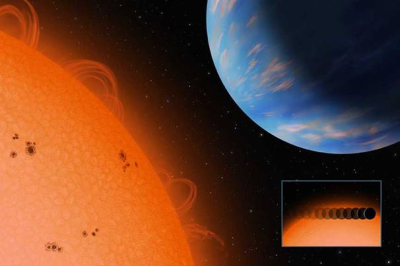01 June 2007

An Artist's Rendition of a Planet Orbiting the Star Gliese 436
Credit: Lynette Cook - Exoplants.org
On Monday, 28 May 2007, an international team of researchers announced the discovery of 28 new planets outside our Solar System, known as extrasolar planets or exoplanets. By this bounty of discoveries, the total number of exoplanets increases to 236.
The new exoplanets were reported in the semi-annual meeting of the American Astronomical Society (AAS) in Honolulu. This research is a collaborative work of the California and Carnegie Planet Search team and the Anglo-Australian Planet Search team.
During 2006, the team discovered 37 new objects orbiting other stars. Seven of these objects were confirmed to be brown dwarfs, objects of intermediate mass between stars and planets. They are believed to be failed stars, as they did not reach the hydrogen-burning phase of stellar evolution. A brown dwarf is much more massive than Jupiter, the largest planet in the Solar System. Two other objects are of critical masses, and could be either giant planets or small brown dwarfs.
Most exoplanets have not been imaged, but rather indirectly detected through innovative techniques. For example, due to their relatively strong gravitational influence, exoplanets and brown dwarfs may be detected by measuring the tiny wobbles they induce in the paths of their parent stars. The team reports that they refined their analyses to detect even smaller stellar wobbles.
"We have added 12% to the total in the past year, and we are very proud of that," said Dr. Jason T. Wright of the team. "This provides new planetary systems so that we can study their properties as an ensemble."
In addition to reporting 37 new substellar objects, Wright highlighted a discovery made by the team two years ago. It is an exoplanet similar to the giant planet Neptune in size and icy structure.
This Neptune-sized planet orbits the nearby red dwarf star Gliese 436 (GJ 436), 30 light years away. The team estimated this planet's mass to be at least 22 Earth masses. (Neptune is 17 times more massive than Earth.) Wright described this wonderful world as "extraordinarily rich".
After the publication of the exoplanet's orbit earlier this year, a Belgian astronomer, Michael Gillon at Liege University, observed the planet passing in front of its parent star. Gillon and collaborators reported recently how this transit event allowed them to precisely compute the planet's mass (22.4 Earth masses), its radius and density, which turned out to be similar to Neptune's.
"From the density of two grams per cubic centimeter—twice that of water—it must be 50 percent rock and about 50 percent water, with perhaps small amounts of hydrogen and helium," said Geoff Marcy, a principal investigator of the team. "So this planet has the interior structure of a hybrid super-Earth/Neptune, with a rocky core surrounded by a significant amount of water compressed into solid form at high pressures and temperatures."
This extrasolar Neptune orbits Gliese 436 every 2.6 days. This means the exoplanet is very close to the star, at only 3% of the Sun–Earth distance, indicating that it is a "hot Neptune", Wright said. Unlike most other giant exoplanets, its orbit is very elongated, not circular. Actually, this orbit indicates that the star may have another planetary companion in a larger orbit.
"I am sure people will immediately follow up and try to measure the atmospheric composition of this planet." Wright anticipated.
Also, the 28 new exoplanets include at least four multiple-planet systems, plus three stars that probably contain a brown dwarf companion. Wright said that at least 30% of all stars known to have planets have more than one. Scince smaller planets and outer planets of a star are difficult to detect, he predicts that the percentage will continue to rise as detection methods improve.
"We are just now getting to the point where, if we were observing our own Solar System from afar, we would be seeing Jupiter," he said, demonstrating that the teams' measurement technique is now sensitive to stellar wobbles of a meter per second. This is much finer than the resolution limit that was available 15 years ago, when the exoplanet quest started.
Wright records all known exoplanets for the California and Carnegie Planet Search team's Website, http://exoplanets.org, which features the only peer-reviewed catalog of exoplanets within approximately 650 light years from Earth.
Further Reading
California and Carnegie Planet Search
http://exoplanets.org/aasjune07s/pr_280507.htm
Anglo-Australian Planet Search
http://www.phys.unsw.edu.au/~cgt/planet/
Aymen Mohamed Ibrahem
Senior Astronomy Specialist